

I spent almost the first hour of my visit to the museum poring over the intricacies of Jesús Bubu Negrón’s “La Promesa,” a video, wheelchair, and copier-reproduction-shrink- wrapped-on-cheap-lacquered-wood foto-novela installation. Roughly speaking, it’s about Negrón’s pilgrimage to a gallery in Mexico City to deliver one of his mother’s wheelchairs – this act by itself was, apparently, Negrón’s contribution to the exhibition – but it also deals centrally with conflicting inter-generational aspirations, a young artist’s flailing, memory; the whole cosmic kit and kaboodle. The clunky video is initially funny but soon becomes almost unwatchable, as Negrón gets falling-down drunk while dragging the wheelchair from bar to bar on the way to the gallery. I liked the foto-novela for its equal parts of affection and exasperation, and the way its handmade, low-tech qualities harken to both dime store and comic underground roots. I appreciated the installation’s overall look as well: the actual wheelchairs, the record bin arrangement for the loose pages of the foto-novela, the pedestal for the video. It succeeded, more or less, as both a critical idea of what a museum installation should look like, and a real memorial altar of a contemporary, underground-culture kind.
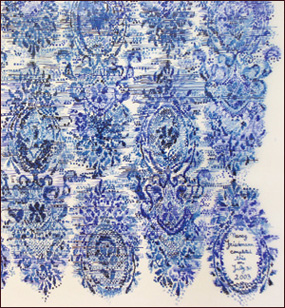
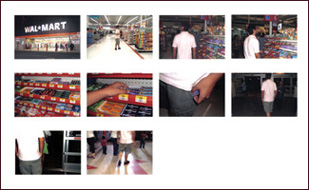
Michael D. Linares’ theft-of-chewing-gum snapshot documentary was likewise an unexpected hit of lightweight wise-ass antiestablishmentarianism for a metropolitan museum show that generally took itself pretty seriously. It was nice to peer over Linares’ vitrine full of snide fun at the Byzantine goings-on beyond it, a wall sized, hand drawn decorative grid work of ink on mylar by Nancy Friedemann; meticulous, perhaps god-mad, in a way that only a sturdy youth with access to copious amounts of No-Doz – or even skankier stuff – would even contemplate. Neatly done, in both cases.
I’m always a sucker for painting, whatever else the scene is palpating, and perhaps for that reason alone I stopped to contemplate David Antonio Cruz’ triptych of the artist himself, plus one steer, in provocative unbuttoned-jeans and swollen-lips deshabille. I usually dismiss art works based on pornography as so derrière-garde, so last decade, but this lively trio, with its tropical hues and just-showy-enough-for-the-job workmanship, pleased me. But David, I thought to myself, lose those frames.
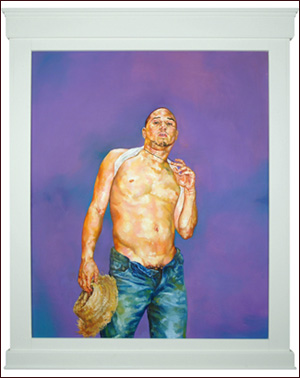
Nearby hung Carlos Aponte’s two highly entertaining episodes of minimalist burlesque in the form of hallucinogenic embroideries, needlework so aggressive I had to duck when I came face-to-face with it. Aponte employs an airport signage aesthetic to make points similar to Cruz’, and his work is likewise saturated with sex, although it also froths over into gender roles, hierarchies, and many other precepts of identity-focused art. But Aponte is considerably less burdened with academic blather than many artists who do this sort of work, and appears to be having loads more fun. Imagine airport concourses with symbols for men with big cigars and erect penises, women with zippered or available vaginas, houses going up in flames, and boys blowing their brains out. Ha ha ha.
At some point in my winding trajectory through “The S Files,” my journey of discovery began to settle heavily, like too much lechón grasiente. I was probably dawdling too long by the works that had their allure, though I tried to spread the love around. I was really rooting for Carlos Motta’s artist’s book and sound installation, for example – one ought to be for anything that is against the School of the Americas – and the various artists working with make-up struck me as at least as original as Janine Antoni’s work from over a decade ago. But my enthusiasm finally petered out altogether in the vicinity of the video theater of relentless boredom – these group shows need espresso and quesito stations every tenth work or so – and, in retrospect, I can imagine saying to myself, in a fed-up, subverbal mumble, what Quintín spoke aloud, and with about as much solid reasoning: A lot of the show looked juvenil and derivada after a while, I could not say derivative of what, exactly, but I knew I’d seen it before, usually better, often by far. I suppose this is what biennials and other “selected works” shows are for: A chance for lazy to be as lazy does and for nebulosity and strong feelings to stand up and be counted. That’s fine. Official encouragement for such behavior does not come down the pike every day, and so, to mix a metaphor in honor of a the exhibition’s mixed results, when the shoes fits, why not put it on?
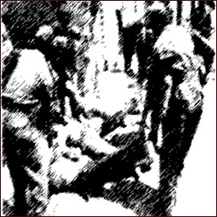
Images from top, left, on down: Nancy Friedemann, detail from “Untitled,” 2003, ink on mylar, 90 x 180 inches. Michael Linares, “Un sistema para la descontextualización de una cosa en cosa de arte (robo de chicles),” 2004, 10 1-Hour Photo prints, 8 x 10 inches each. David Antonio Cruz, “Enthralled on la capilla de cristo,” 2004, oil on canvas, 60 x 72 inches. Carlos Motta, letterpress print, 9.5 x 9.5 inches, from “SOA: Black & White Pain-tings,” 2005, 12-page accordian book with audio CD. All images are courtesy of the Museo de Arte de Puerto Rico.

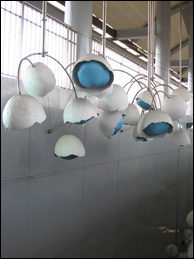 San Francisco Station
San Francisco Station
“Paisaje marino”
by Lourdes Correa Carlo
31 feet long by 15 high by 9 wide
porcelain and stainless steel
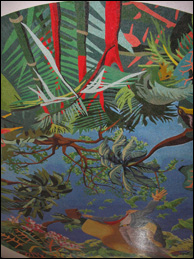 Martínez Nadal Station
Martínez Nadal Station
“Con las cotorras” by Nathan Budoff
1400 square foot ceiling mosaic, detail
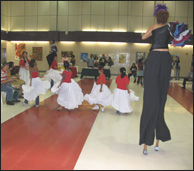 Rio Piedras Station
Rio Piedras Station
“Alejita” by Cristina Piffer
2000 square foot synthetic floor
with etched names
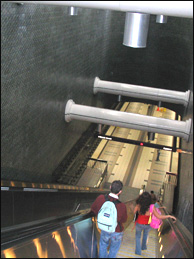 Universidad Station
Universidad Station
“Empapelando la ciudad”
by Eric Schroder Vivas
tiled walls
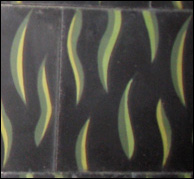 detail of above
detail of above